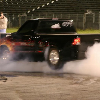2000StreetRod
Moderator Emeritus
- Joined
- May 26, 2009
- Messages
- 10,597
- Reaction score
- 334
- City, State
- Greenville, SC
- Year, Model & Trim Level
- 00 Sport FI, 03 Ltd V8
Timing chain wear
My current opinion of what causes timing chain related component wear is lack of lubrication and chain slap.
Under normal circumstances on engine startup oil reaches the rear upper cassette before the front upper cassette and front lower tensioner/guide. The lack of lubrication results in friction wear of the plastic surfaces that contact the chains.
The OHV V6 crankshaft to camshaft chain tensioner is a ratchet type device that uses spring and oil pressure. The SOHC V6 crankshaft to jackshaft tensioner uses only spring pressure. As the spring weakens with age the chain tension decreases and chain slap increases. Chain slap accelerates wear of the plastic contact surfaces. Chain slap eventually increases until the chain contacts metal surfaces. Chain to metal contact eventually results in chain failure.
The upper chain tensioners are spring loaded pistons that utilize oil pressure. The springs provide chain tension until oil pressure builds. The springs weaken with age allowing chain slap at startup until oil pressure builds. Chain slap accelerates guide wear. Replacing the upper chain tensioners every 75,000 miles will reduce startup chain slap and guide wear.
I suspect that the lower front chain tensioner and guide is the least reliable. I think that the upper left front guide assembly is the next least reliable and the upper right rear guide assembly is the most reliable. In my case the upper rear guide was much more worn than the upper front guide. I suspect that the rear tensioner has never been replaced but that the front tensioner has. When I installed the 00M12 kit the old front tensioner spring was almost as strong as the new one in the kit.
My current opinion of what causes timing chain related component wear is lack of lubrication and chain slap.
Under normal circumstances on engine startup oil reaches the rear upper cassette before the front upper cassette and front lower tensioner/guide. The lack of lubrication results in friction wear of the plastic surfaces that contact the chains.
The OHV V6 crankshaft to camshaft chain tensioner is a ratchet type device that uses spring and oil pressure. The SOHC V6 crankshaft to jackshaft tensioner uses only spring pressure. As the spring weakens with age the chain tension decreases and chain slap increases. Chain slap accelerates wear of the plastic contact surfaces. Chain slap eventually increases until the chain contacts metal surfaces. Chain to metal contact eventually results in chain failure.
The upper chain tensioners are spring loaded pistons that utilize oil pressure. The springs provide chain tension until oil pressure builds. The springs weaken with age allowing chain slap at startup until oil pressure builds. Chain slap accelerates guide wear. Replacing the upper chain tensioners every 75,000 miles will reduce startup chain slap and guide wear.
I suspect that the lower front chain tensioner and guide is the least reliable. I think that the upper left front guide assembly is the next least reliable and the upper right rear guide assembly is the most reliable. In my case the upper rear guide was much more worn than the upper front guide. I suspect that the rear tensioner has never been replaced but that the front tensioner has. When I installed the 00M12 kit the old front tensioner spring was almost as strong as the new one in the kit.











